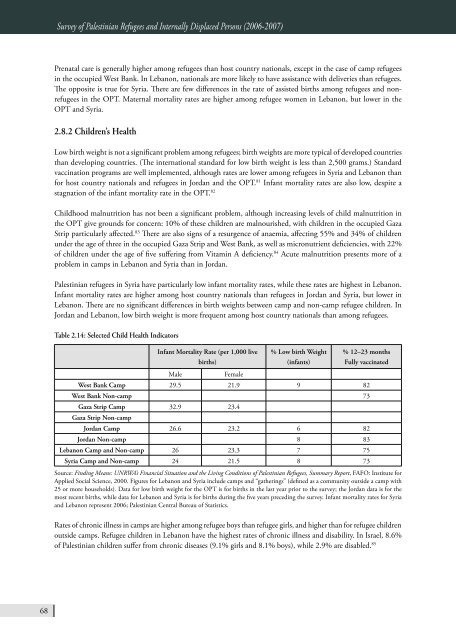BADIL Resource Center for Palestinian Residency and Refugee
BADIL Resource Center for Palestinian Residency and Refugee
BADIL Resource Center for Palestinian Residency and Refugee
Create successful ePaper yourself
Turn your PDF publications into a flip-book with our unique Google optimized e-Paper software.
68<br />
Survey of <strong>Palestinian</strong> <strong>Refugee</strong>s <strong>and</strong> Internally Displaced Persons (2006-2007)<br />
Prenatal care is generally higher among refugees than host country nationals, except in the case of camp refugees<br />
in the occupied West Bank. In Lebanon, nationals are more likely to have assistance with deliveries than refugees.<br />
The opposite is true <strong>for</strong> Syria. There are few differences in the rate of assisted births among refugees <strong>and</strong> nonrefugees<br />
in the OPT. Maternal mortality rates are higher among refugee women in Lebanon, but lower in the<br />
OPT <strong>and</strong> Syria.<br />
2.8.2 Children’s Health<br />
Low birth weight is not a significant problem among refugees; birth weights are more typical of developed countries<br />
than developing countries. (The international st<strong>and</strong>ard <strong>for</strong> low birth weight is less than 2,500 grams.) St<strong>and</strong>ard<br />
vaccination programs are well implemented, although rates are lower among refugees in Syria <strong>and</strong> Lebanon than<br />
<strong>for</strong> host country nationals <strong>and</strong> refugees in Jordan <strong>and</strong> the OPT. 81 Infant mortality rates are also low, despite a<br />
stagnation of the infant mortality rate in the OPT. 82<br />
Childhood malnutrition has not been a significant problem, although increasing levels of child malnutrition in<br />
the OPT give grounds <strong>for</strong> concern: 10% of these children are malnourished, with children in the occupied Gaza<br />
Strip particularly affected. 83 There are also signs of a resurgence of anaemia, affecting 55% <strong>and</strong> 34% of children<br />
under the age of three in the occupied Gaza Strip <strong>and</strong> West Bank, as well as micronutrient deficiencies, with 22%<br />
of children under the age of five suffering from Vitamin A deficiency. 84 Acute malnutrition presents more of a<br />
problem in camps in Lebanon <strong>and</strong> Syria than in Jordan.<br />
<strong>Palestinian</strong> refugees in Syria have particularly low infant mortality rates, while these rates are highest in Lebanon.<br />
Infant mortality rates are higher among host country nationals than refugees in Jordan <strong>and</strong> Syria, but lower in<br />
Lebanon. There are no significant differences in birth weights between camp <strong>and</strong> non-camp refugee children. In<br />
Jordan <strong>and</strong> Lebanon, low birth weight is more frequent among host country nationals than among refugees.<br />
Table 2.14: Selected Child Health Indicators<br />
Infant Mortality Rate (per 1,000 live<br />
births)<br />
Male Female<br />
% Low birth Weight<br />
(infants)<br />
% 12–23 months<br />
Fully vaccinated<br />
West Bank Camp 29.5 21.9 9 82<br />
West Bank Non-camp 73<br />
Gaza Strip Camp 32.9 23.4<br />
Gaza Strip Non-camp<br />
Jordan Camp 26.6 23.2 6 82<br />
Jordan Non-camp 8 83<br />
Lebanon Camp <strong>and</strong> Non-camp 26 23.3 7 75<br />
Syria Camp <strong>and</strong> Non-camp 24 21.5 8 73<br />
Source: Finding Means: UNRWA’s Financial Situation <strong>and</strong> the Living Conditions of <strong>Palestinian</strong> <strong>Refugee</strong>s, Summary Report, FAFO: Institute <strong>for</strong><br />
Applied Social Science, 2000. Figures <strong>for</strong> Lebanon <strong>and</strong> Syria include camps <strong>and</strong> “gatherings” (defined as a community outside a camp with<br />
25 or more households). Data <strong>for</strong> low birth weight <strong>for</strong> the OPT is <strong>for</strong> births in the last year prior to the survey; the Jordan data is <strong>for</strong> the<br />
most recent births, while data <strong>for</strong> Lebanon <strong>and</strong> Syria is <strong>for</strong> births during the five years preceding the survey. Infant mortality rates <strong>for</strong> Syria<br />
<strong>and</strong> Lebanon represent 2006; <strong>Palestinian</strong> Central Bureau of Statistics.<br />
Rates of chronic illness in camps are higher among refugee boys than refugee girls, <strong>and</strong> higher than <strong>for</strong> refugee children<br />
outside camps. <strong>Refugee</strong> children in Lebanon have the highest rates of chronic illness <strong>and</strong> disability. In Israel, 8.6%<br />
of <strong>Palestinian</strong> children suffer from chronic diseases (9.1% girls <strong>and</strong> 8.1% boys), while 2.9% are disabled. 85

















